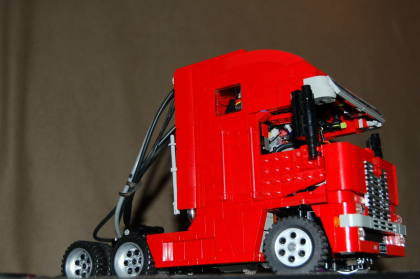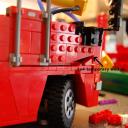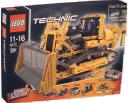Finished!
Yesterday I got upwards of fifty pageviews, and thats enough to make me feel guilty enough to post. The Argosy survived the airplane ride both to and from PDX, so I'm happy to present the finished truck.
For those of you new to the model, its a fully functional Freightliner Argosy cab-over-engine Tractor Trailer. This includes Forward/Reverse, two speed gearbox, 40° full Ackerman steering with suspension, LED headlights, air compressor, pneumatic steps, and tilting cab! It was started May 2006, taking coutless hours to complete. I brought it to Brickfest 2007, and promised the folks there I would update the blog soon, so here goes! Heres whats new since my last entry. I may go through some parts in more detail later.
Heres whats new since my last entry. I may go through some parts in more detail later.
Its got a 9v battery lodged near one of the windows. This powers the carefully hidden master switch. Flip this on and the headlights light up and the air pump starts. The pressure is automatically regulated: I modified a 1cc syringe to push a spring up against a button, turning the pump off. All the electronics are crammed in the back of the cab, hidden (and held in) by a black panel. The doors and staircases have been finished and tested. Opening either door will pull a pneumatic switch, which opens a small staircase below it, just like in the real truck. There are air tubes running out of the back of the cab to the controller. They control the two speed gearbox. Also, there is a switch in the back of the cab which controls the air to the trailer.
The doors and staircases have been finished and tested. Opening either door will pull a pneumatic switch, which opens a small staircase below it, just like in the real truck. There are air tubes running out of the back of the cab to the controller. They control the two speed gearbox. Also, there is a switch in the back of the cab which controls the air to the trailer.
There are also some shiny new mirrors. They are made of glossy heat-to-apply paper, ironed and glued onto Legos. They do not look perfect, but they are at least shiny. Also projectArgosy.blogspot.com is advertised proudly on the front visor.
All in all there is a fair amount of non-Lego on this model. It is difficult to remain a 'purist' model this small without sacrificing funtion. -Most obviously, theres the LEDs, pressure switch, and the decals.
-Various places I've used small metal spacer washers - mainly on the rear axles; they prevent the pins in the Model Team hubs from knocking on the frame.
-I sand-casted a solder 1x2 plate, for use on the fifth wheel. The metal brick adds weight, making the fifth wheel automatically latch when it backs up under a trailer.
-Since Lego doesn't make elbows for pneumatics, I bored out a few Fischertechnik ones to use various places, especially one the lowboy. They make fitting tubing much more doable.
-I used small amount of rubber cement in various areas: on the steering, the gray pins would constantly work themselves out. Adding a little rubber cement is not permanent, but makes them hold better. I also applied some to help hold down the 4x8 slope bricks on the roof. Unfortunately, this did not work for more than a week, and you can notice the small crack in the front in the photos. Unavoidable, because there are no studs or tubes there!
I've also modified some pieces in my attempt to achieve perfection:
-Most obviously, I had to cut a 4x8 slope in half, to accommodate the 14-wide roof.
-For the gearbox I filed the ridges off the axle joiner which the driving ring slides on. This allows smooth silent shifting and no need for exorbitant air pressure.
-In the steering assembly, I decided against the gray frictionless pins because they have too much slop. Instead I filed off the friction ridges from black ones and the Pin Double with Axle Hole, resulting in frictionless but stable motion.
-If you look closely at the picture of the underside of the steering, you can see where I used a technic bush 1/2 sawed in half, and some shortened pins. I also sawed 1x6 thin liftarms in half to create 1x3s.
-For the staircases to work smoothly slide out, the bottom plate needs to have a curved face. This was achieved by turning a round corner 3x3 into a 3x2.
-Each door employs custom a 1x3.5 plate. What else could I do?
As much as I'd never like to admit it, this design is not perfect. :-) When the truck turns, the axles which hold on the front wheels pull out. This needs to be checked about every 0.0011 miles. I believe this is from having too much Ackerman adjustment. Also, the front set of rear axles will begin to pull off, as they are only held on with the 24z crown gear.
The cab is not completely symmetrical either. For example, the right door uses a 2x4 wedge plate, and the other a 2x3. The 2x4 is is stronger, but the 2x3 looks better, I just couldn't make up my mind!
I opened up the cab to take pictures and the headlights stopped working. One of my solder joints pulled. It was not threaded through the hinge point, and needed an inch or so more wire which it didn't have. This will be difficult to fix, as you don't exactly stick a 3100°F degree soldering iron into a Lego construction.
Fun fact: The truck ways just a little over 2.5lbs(1.13kg). Of this weight, about 1.75lbs(0.8kg) is over the front wheels. They still don't flex a bit!
Fun fact: In order to have space for the front axle suspension, theres a 4Ldraw-unit(or half of a plate) gap between the frame and the steering assembly. This required turning 1x4 Technic beams upside-down!
I'm not sure where I'm going next. Time for a break from miniaturization, for sure. I may make some B-train trailers, or give it an NXT brain in a trailer, or some such fun. If I had all the money and time I wanted, I'd build another, larger version, using the Black Cat tires. You never know....
Head over to my Brickshelf Gallery to see all the pictures!
--Peter Ehrlich














